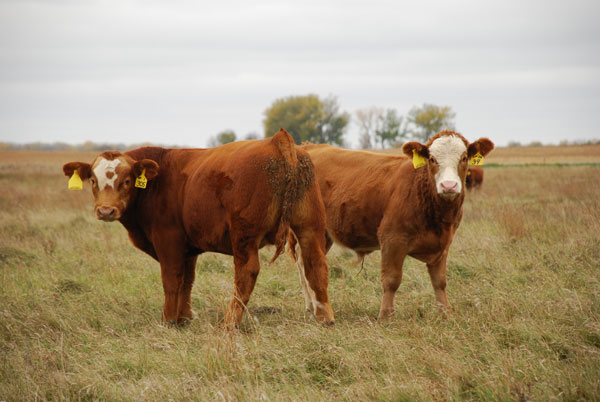August 4, 2016

The American rancher is amazing—give us a target and a little incentive, and we will produce it. However, the challenge of late is trying to determine what environment we are operating in and what the targets are.
Overall there remains an understandable degree of uncertainty surrounding the market, especially after experiencing a historically large decline in prices recently. In and of itself, that doesn’t portend well for the beef business, but one tends to feel a little better if you consider that per-capita meat consumption showed its largest jump in roughly 40 years recently. Further, consider that supplies of beef and competing proteins are expected to increase the next couple of years at a much slower rate.
Demand has remained astonishing considering the underlying fundamentals: a strengthening U.S. dollar which sharply curtailed exports, the worst performing economy in four decades and one of the largest drops in disposable income for the middle class in the post-depression era. None of these factors are positive and more importantly, these trends appear to be long term, at least to some degree.
However, there are some positive long-term trends at work as well. First, there’s a world population that is expected to reach 9 billion-plus in the next 35 years. Then, while the middle class is shrinking and poverty is growing in the U.S., the trend globally is just the opposite. And most importantly, when given the choice, the world prefers high-quality beef and the U.S. is the largest and most efficient producer of that product.
The short-term trend for the overall health of the beef business is gradually weaker, but the long-term fundamentals are positive. It would require a pessimist of gigantic proportions not to be excited about the future of the beef industry.
The question for ranchers is this: what do I produce and how do I produce it, so that we can ensure our competitiveness in the future and position ourselves for the most consistent and largest profits?

BEEF Seedstock 100 List
Looking for a new seedstock provider? Use our UPDATED Seedstock 100 listing to find the largest bull sellers in the U.S. Browse the list here.
Profitability and success seem to boil down to four relatively well-defined categories – genetics, management, marketing and relationships. The first may be the easiest to define and achieve, and also the most challenging. Market and/or economic signals are pretty clear cut for most traits and whether they are threshold traits or traits with diminishing levels of return, the optimum range is fairly well known by producers, given their environment and marketing strategies.
As producers, we tend to focus on production traits and will continue to make incredible progress in these areas. What is optimum today will likely be well below average in a decade, but we have the tools and the information to continue to move forward in these areas.
However, it becomes more difficult to assess our present and future when we begin to make the leap from the economic drivers of the feeding sector to the packing sector and eventually to the consumer. The reason for the uncertainty in part is that should margin operators, which is what feeders and packers are, develop a silo mentality and assume they have no vested interest in beef demand, it can tend to distort market signals.
Compound that with the fact that there are many different consumers and that consumer trends tend to change, plus the real substantive genetic antagonisms we contend with, and it becomes more difficult for ranchers to determine what the targets are.
Weight has been king for quite some time and with the spread between cost of gains and prices being so dramatic, that will likely continue to be the case for quite some time. But there is a limitation. Chasing weight at the feedbunk affects mature size and efficiency at the cow-calf level at some point, and we run into portion size and product limitations at some point as well.
I can still remember when the first National Beef Quality Audit was done and there was considerable talk then about red meat yield, retail yield, muscle and leanness. It was made clear that fat was a problem and closely trimmed products shifted the paradigm. There was talk then of wanting to produce all Yield Grade 1s and 2s.
However, a combination of things have led us to a point where we are killing cattle at fatter end points, heavier weights and being increasingly rewarded for marbling. Ironically, the industry has almost abandoned USDA’s Yield Grade formula. The electronic cameras now used in packing plants are better predictors of red meat yield and economics have made the pursuit of leaner Yield Grades essentially a joke.
If you are selling on a typical grid, you are leaving money on the table if you aren’t producing 10% or higher Yield Grade 4s. Discount lines for heavy carcasses continue to rise, and while packers and feeders are striving to produce 900-pound carcasses, they don’t necessarily want the subsequent increase in ribeye area that would result in Yield Grade 1s or 2s.
Efficiency, weight and marbling seem to be the drivers and we have the tools to make dramatic strides in all three simultaneously. It is important to note that efficiency and weight are interrelated and apply to all segments of the business with sometimes confounding results.
For cow-calf producers, the impact of genetics, management, marketing and relationships is growing larger and more competitive. The reason for that is that the tools to accomplish these goals are improving greatly.
The result is that we are seeing every segment of the industry change and differentiate. Currently, it is most pronounced at the seedstock and cow-calf level, but the gap between the haves and have nots, between the progressive and traditional mindsets, and the commodity and value-added perspectives is widening.
As producers, we have to decide first where we are going to compete and then what it will take to compete in that arena. Easier said than done.
You might also like:
4 facts to debunk "Meat is horrible" article
60 stunning photos that showcase ranch work ethics
Best risk strategy options for cattle producers
Does it really take six years to cover your costs on a cow? NO!
Photo Gallery: Get to know the 2016 Seedstock 100 operations
About the Author(s)
You May Also Like



